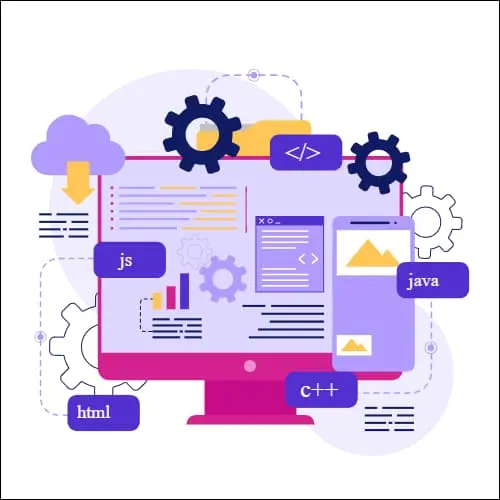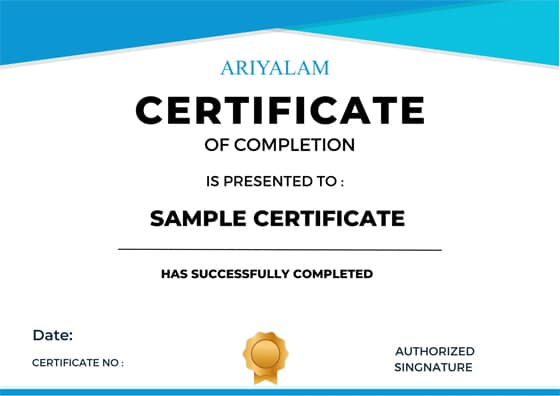Full Stack Developer Course Online
Our Full Stack Developer course online is designed to transform aspiring tech enthusiasts into proficient developers capable of building complete web applications. Covering both front-end and back-end technologies, students will gain hands-on experience in HTML, CSS, JavaScript, databases, and server management. This comprehensive training equips learners with in-demand skills, preparing them for versatile roles in the tech industry, from startups to established enterprises.

Full Stack Developer Course Fees
Key Features
Full Stack Developer Certification

Key Features
Full Stack Developer Certification

Full Stack Developer Course Online Prerequisites:
Our Full Stack Developer Course Online is designed to help learners build versatile web development skills. While beginners are welcome, some foundational knowledge in programming is beneficial. Familiarity with HTML, CSS, and JavaScript basics will enhance your experience. Problem-solving skills and a passion for coding will also contribute to your success.
Full Stack Developer Course Syllabus
HTML5 and CSS3
HTML Basics
- Basic tags: headings, paragraphs, links, lists, and images
- New HTML5 tags
- Forms and validations
- Local storage and IndexDB for storing data in the browser
CSS3 Basics
- CSS syntax and selectors
- Styling elements: colors, borders, margins, padding
- CSS3 properties: gradients, shadows, and rounded corners
- Animations and transitions
- Tooltips, flexbox, and CSS grid for layout
CSS Framework: Bootstrap
- Setting up and using Bootstrap for responsive design
- Layouts with Bootstrap grid
- Using Bootstrap components like navigation bars, buttons, modals
2. JavaScript and jQuery
JavaScript Basics:
Getting Started
- Introduction to JavaScript: variables, data types, operators, and expressions
- Functions, parameters, and return values
- Flow control: if statements, loops, switch cases
JavaScript Essentials
- Objects, arrays, and common methods (sort, filter, map)
- Functions: hoisting, closures, and scope
- Error handling and debugging
Working with the DOMs
- Selecting and modifying HTML elements
- Adding and removing elements dynamically
- Event handling (clicks, mouseover, etc.)
- Introduction to the Browser Object Model (BOM): window, screen, location, history, cookies
JavaScript and JSON
- Data types in JSON
- Parsing and stringifying JSON data
- Using JSON in AJAX and API calls
JavaScript vs. jQuery
- Basics of jQuery: selectors, events, and animations
- DOM manipulation with jQuery
- AJAX calls with jQuery
3. AJAX and Asynchronous Programming
AJAX Fundamentals
- XMLHttpRequest and Fetch API for asynchronous data loading
- Promises and async/await for handling asynchronous tasks
- Working with APIs and fetching data
4. Angular
Modern Front-End Framework
Getting Started with Angular
- Introduction to Angular and key features
- Setting up an Angular project and basic project structure
- Components, modules, and services
Angular Essentials
- Data binding: one-way and two-way
- Pipes for data transformation
- Directives (ngIf, ngFor, ngSwitch) for conditional rendering
Forms in Angular
- Template-driven and reactive forms
- Form validation and error handling
Angular Services and HTTP Client
- Creating and injecting services
- Using HTTP Client for API calls
- Observables and RxJS
Routing and Navigation
- Defining routes and navigating between components
- Route guards and lazy loading
Building & Deployment
- Building Angular apps with ng build
- Deploying an Angular app
5. Databases
Database Essentials for Full Stack Development
MongoDB (NoSQL Database)
- Introduction to MongoDB and NoSQL concepts
- Basic CRUD operations (Create, Read, Update, Delete)
- Mongoose for schema-based data modeling
- Indexing, aggregation, and connecting MongoDB with Node.js
MySQL (Relational Database)
- Basics of MySQL and SQL queries
- CRUD operations and managing relationships
- Connecting to MySQL from Node.js using the MySQL library
6. Node.js and Express
Back-end development with JavaScript
Node.js Basics
- Setting up Node.js and using Node Package Manager (NPM)
- Core concepts: asynchronous programming, event loop, and callbacks
- File system, buffers, and managing modules
Express Framework
- Setting up Express for handling server requests and responses
- Routing, middleware, and creating RESTful APIs
- Using JSON for API responses and data handling
Template Engines and Views
- Introduction to template engines (e.g., EJS)
- Creating dynamic views with templating
File Handling in Node.js
- Reading and writing files
- Asynchronous file operations
WebSocket’s and Real-Time Communication
- Setting up Socket.io for real-time communication
- Building a simple chat application with Express and Socket.io
7. Building Full-Stack Projects
Putting It All Together
Basic CRUD Applications
- Building CRUD operations (Create, Read, Update, Delete) with Node.js and MongoDB
- Integrating front-end with Angular or React
Authentication and Authorization
- Using JSON Web Tokens (JWT) for secure authentication
- Implementing roles and permissions for protected routes
- Handling exceptions and using implicit objects in JSP
- MVC pattern implementation in JSP
Deployment
- Deploying applications to cloud platforms (e.g., Heroku, AWS, or DigitalOcean)
- Environment management and setting up production configurations
8. PHP Essentials (Optional)
Introduction to Server-Side Scripting with PHP
- Basics of PHP and setting up a PHP server
- PHP and MySQL for database operations
- Basic CRUD operations with PHP
FAQ:
1. What is a Full Stack Web Development?
2. What will I learn in a Full Stack Developer course online ?
You’ll learn HTML, CSS, JavaScript, back-end programming (often Python, Ruby, or Node.js), database management, APIs, version control, and how to deploy full-stack applications
3. How long does it take to become a Full Stack Certification Course?
4. Do I need prior coding experience?
5. What career opportunities are available after completing a Full Stack developer course online?
Graduates can pursue roles like Full Stack Developer, Web Developer, Software Engineer, and Front or Back-End Developer, with demand in industries across tech, finance, and more.
6. What top companies have Jobs in Full Stack Developer?
Enquiry Now
